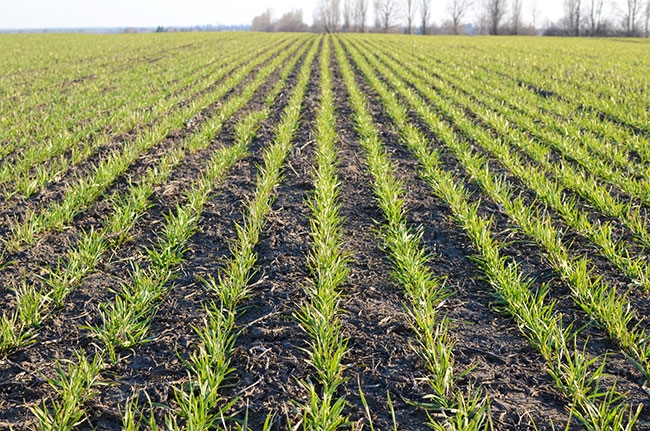
Features
Agronomy
Seeding/Planting
Growing winter wheat: 4 top tips
Winter wheat can be a great crop to include in your rotation. Winter wheat will typically out yield spring wheat by 20 per cent or more, depending on growing conditions, and is normally harvested several weeks before spring wheat.
July 25, 2017 By Ross H. McKenzie PhD P.Ag.
 Winter wheat will typically out yield spring wheat by 20 per cent or more Winter wheat can be a great crop to include in your rotation.
Winter wheat will typically out yield spring wheat by 20 per cent or more Winter wheat can be a great crop to include in your rotation.Winter wheat in your rotation can make more efficient use of seeding, spraying and harvest equipment and spread out the field workload on your farm. If you’re considering planting winter wheat this fall, you should start your planning now, as successful winter wheat production takes long-term planning.
Land must be available for timely winter wheat seeding this fall, so a shorter season crop that can be harvested by mid- to late August should be seeded in the spring. Depending on the area you farm, consider crops such as cereal silage, pea, Polish canola or mustard.
Variety selection
An important consideration when deciding to grow winter wheat is how it will be marketed, as this will influence variety selection. Winter wheat can be used for milling for human consumption, livestock feed or ethanol production. A number of excellent new varieties have been released, but only some are suitable for milling.
You can review the ratings of each variety on the Western Winter Wheat Initiative website at growwinterwheat.ca. The website includes summary tables for Alberta, Saskatchewan and Manitoba; each province uses a different variety as the standard to which other varieties are compared.
When reviewing the tables, yield potential should not be your first consideration. Instead, decide which characteristics are most important for the area you farm. For example, if winter hardiness, lodging and Fusarium disease tolerance are your greatest concerns, select the variety with the strongest attributes in those categories. The variety with the best attributes for your area will usually have the highest yield potential on your farm as well.
Establishing winter wheat
Ideally, winter wheat should be direct seeded into standing stubble. Canola, mustard or cereal silage stubble works well. Maintaining standing stubble after seeding is best in order to trap snow, which will provide insulation and help with winter survival. Seeding into pulse stubble, such as pea, can provide additional nitrogen release the following year, but the lack of standing stubble for snow trapping can be a limitation.
Southern Prairie farmers in the Black and Gray soil zones should seed winter wheat in the last week of August or the first week of September.
Farmers in the Brown and Dark Brown soil zones should seed winter wheat in the first two weeks of September.
These seeding times are recommended to ensure winter wheat will germinate, emerge, grow to at least the three-leaf stage and then develop a good crown root system before freeze up, all of which will help to ensure overwinter survival. When plants are only at the one- or two-leaf stage before freeze up, overwinter survival may be reduced, particularly during a harsh winter.
Research in southern Alberta has shown that when seeding is delayed from the second week of September to the first week of October, winter wheat yield will decline in the range of 15 to 25 per cent, depending on environmental conditions. Harvest the next year can also be delayed by two or more weeks. When this happens, the advantage of higher yield and earlier harvest of winter wheat versus spring wheat may be lost.
Seed winter wheat to achieve a plant stand of 25 plants per square foot in the Brown and Dark Brown soil zones. In the Black soil zone or on irrigated fields, seed to achieve 30 to 35 plants per square foot. Be sure to calculate your seeding rate in pounds per acre (lb/ac). Determine thousand kernel seed weight in grams (g) and estimate your seedling survival rate; I usually use about 75 per cent (0.75).
The formula to calculate the seeding rate in pound per acre is:
Seed rate (lb/ac) = [target plant population/ft2 × thousand kernel weight (g)] ÷ seedling survival (0.75) ÷ 10
Winter wheat has considerable ability to tiller in spring, however, the best yields are obtained using higher seeding rates.
Watch seeding depth
A common mistake new growers make is seeding winter wheat a little too deep. Winter wheat should be seeded no more than one inch deep, as it has a shorter coleoptile than other cereals. This is the extension of the seed embryo that pushes its way through the soil to the surface, from which the first leaf develops. If you seed at two inches, this can seriously reduce emergence. It will also delay emergence and cause weaker, spindly seedlings that are more susceptible to disease and winterkill.
Soil moisture is often low in stubble fields when the time is right to seed winter wheat. Farmers are then faced with the choice to either seed into dry soil or wait for rain. I usually suggest seeding winter wheat at the recommended time for your area rather than waiting for rain. If you do seed into dry soil, make sure the seeding operation leaves the seed firmly covered with no more than one inch of soil and that you have good seed-soil contact.
Always seed winter wheat into “clean fields” without any actively growing cereals. The wheat curl mite, an insect that can transmit wheat streak mosaic virus, can be harboured in actively growing green cereals, as well as volunteer grain or grass in roadside ditches. When winter wheat is seeded adjacent to green cereal fields, the mites can move from the host plants into the winter wheat after emergence and spread the virus. Cultural control is the only way to control the mites; they can wrap themselves within wheat leaves for protection, which makes chemical control completely ineffective.
Fertilizer management
Soil testing to determine nitrogen (N), phosphorus (P), potassium (K) and sulphur (S) is important to accurately determine fertilizer requirements.
Stubble fields are usually low in soil N, particularly after a high production crop year. Table 1 provides general nitrogen fertilizer recommendations for various soil zones in Alberta.
When soil moisture conditions are dry at planting, it may be best to apply a portion of estimated N requirements at the time of planting and then apply additional N in early spring, depending on soil moisture conditions.
Research has shown N fertilizer banded before seeding tends to dry out the seedbed. The result is often a rougher and lumpier seedbed. This can negatively affect uniform germination and emergence. Research also showed seed-placed N fertilizer applied at rates greater than 30 lb N/ac using urea (46-0-0) at a seedbed utilization of 10 per cent with only medium soil moisture can have a detrimental effect on winter wheat germination and emergence. When using N rates higher than 30 lb N/ac, it is best to side or mid-row band N at planting.
Another option to consider is controlled release ESN fertilizer. It can be safely seed-placed at rates of up to 80 lb N/ac with a 10 per cent seedbed
utilization.
If you need to apply additional N in spring, broadcast urea or dribble-banded 28-0-0 liquid fertilizer can work reasonably well. When surface applying 46-0-0 and 28-0-0, volatilization – the conversion of urea to ammonia gas – is always a concern. Apply N fertilizer as early as possible in the spring, when soil and air temperatures are cool. A urease inhibitor such as Agrotain should be considered to reduce potential volatilization.
Research from Alberta has shown spring broadcast ESN release is too slow to be effective, and is not recommended for winter wheat.
Depending on the soil test P level and yield potential, seed placing approximately 20 to 40 lb/ac of phosphate is usually adequate. Table 2 provides general P fertilizer recommendations used for Alberta. When seeding winter wheat into canola stubble, increase the phosphate rate by 10 lb/ac, as winter wheat is more responsive to P fertilizer after a canola crop.
In the Black and Gray soil zones, deficiencies in K and S are more common. In Brown and Dark Brown soils, sulphur is occasionally low in the zero- to six-inch depth, but sub-soil has adequate sulphate-S. When soil test sulphate-S is less than 10 lb/ac in the zero- to six-inch depth, an additional 10 lb/ac of sulphate fertilizer should be added. Ten lb/ac can be safely seed-placed with winter wheat, as long as no more than 35 lb/ac of phosphate is seed-placed.
In summary, winter wheat can be a great crop to include in your crop rotation. When you follow straightforward management practices, it can be a very profitable crop to grow.

